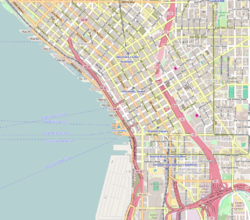
The Alaska–Yukon–Pacific Exposition, acronym AYP or AYPE, was a world's fair held in Seattle in 1909 publicizing the development of the Pacific Northwest. It was originally planned for 1907 to mark the 10th anniversary of the Klondike Gold Rush, but the organizers learned of the Jamestown Exposition being held that same year and rescheduled.
Kenton is a neighborhood in the north section of Portland, Oregon, United States. The neighborhood was originally a company town founded in 1911 for the Swift Meat Packing Company.

The Nippon Kan Theatre is a former Japanese theater in Seattle, Washington, United States. It is located in the Kobe Park Building at 628 S. Washington Street, in the former Japantown section of Seattle's International District.
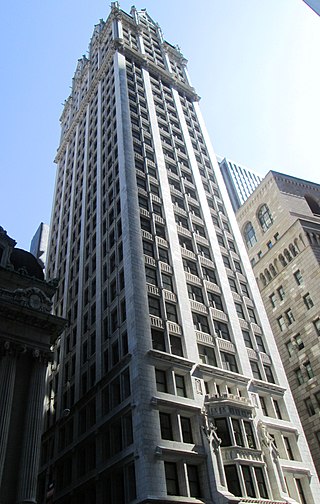
The Liberty Tower, formerly the Sinclair Oil Building, is a 33-story residential building in the Financial District of Manhattan in New York City. It is at 55 Liberty Street at the northwest corner with Nassau Street. It was built in 1909–10 as a commercial office building and was designed by Henry Ives Cobb in a Gothic Revival style.

The Admiral Apartments, originally the Wheeldon Apartments and also known as the Admiral Hotel Apartments, is a five-story brick Tudor Revival apartment building in downtown Portland, Oregon, United States, that was built in 1909. It has been on the National Register of Historic Places since 1990.

Erwin Bratton "Harry" Ault (1883–1961) was an American socialist and trade union activist. He is best remembered as the editor of the Seattle Union Record, the long-running labor weekly published from 1912 to 1928. After termination of the Union Record, Ault worked as a commercial printer for a number of years, before being appointed a deputy U.S. Marshal for Tacoma, Washington, a position which he retained for 15 years.

The Colman Building is a historic office building on First Avenue in downtown Seattle, Washington. It occupies a half of a block in proximity to Pioneer Square, and is bound by First Avenue, Marion, and Columbia Streets. It is listed on the National Register of Historic Places and is a City of Seattle landmark.

The Globe Building, Beebe Building and the Hotel Cecil are a trio of historic office/hotel buildings located in Downtown Seattle, Washington, United States. The buildings occupy the entire west side of the 1000 block of 1st Avenue between Madison and Spring streets. The three buildings were constructed from late 1900 to 1901 for Syracuse-based investors Clifford Beebe and William Nottingham by the Clise Investment Company, headed by businessman James Clise (1855–1938), as a result of the Alaska Gold Rush which fueled the construction of many such buildings in downtown Seattle.

The National Building is a historic warehouse building in downtown Seattle, Washington, located on the east side of Western Avenue between Spring and Madison Streets in what was historically Seattle's commission district. It is now home to the Seattle Weekly. It is a six-story plus basement brick building that covers the entire half-block. The dark red brick facade is simply decorated with piers capped with small Ionic capitals and a small cornice, which is a reproduction of the original cornice. Kingsley & Anderson of Seattle were the architects.

The NAMCO Block is an apartment block built in Windsor, Vermont in 1920-1922. It was listed on the National Register of Historic Places in 1991 as an example of a large-scale company housing project. The building is located at the corner of Union and Main Streets, in the southern part of the historical center of Windsor.
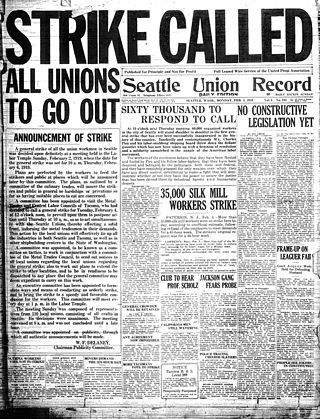
The Seattle Union Record was a union-owned newspaper edited by Harry Ault. The paper was published weekly from February 20, 1900 to April 2, 1918 and was published daily from April 24, 1918 until it discontinued publication in 1928. In its own words, the newspaper was "Published for Principle and Not for Profit".

The Agen Warehouse, also known as the 1201 Western Building is an historic former warehouse building located at 1201 Western Avenue in Seattle, Washington. Originally constructed in 1910 by John B. Agen (1856–1920), widely considered the father of the dairy industry in the Northwest, for his wholesale dairy commission business, it was designed by the partnership of John Graham, Sr. and David J. Myers with later additions designed by Graham alone. After years of industrial use, the building was fully restored to its present appearance in 1986 for offices and retail with the addition of a penthouse and was added to the National Register of Historic Places on January 23, 1998.
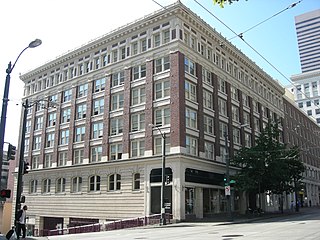
The Lyon Building is a historic building located at 607 Third Avenue in Downtown Seattle, Washington, United States. It was built in 1910 by the Yukon Investment Company and was named after the city in France of the same name, reflecting the French heritage of the company's owners. It was designed by the firm of Graham & Myers in the Chicago school style of architecture and was built by the Stone & Webster engineering firm, whose use of non-union labor would make the yet unfinished building the target of a bombing by notorious union activist John B. McNamara, who would commit the deadly Los Angeles Times bombing only 1 month after. The Lyon Building was luckily not destroyed due to its substantial construction, and after little delay, it was completed in 1911 and soon became one of Seattle's most popular office addresses for lawyers and judges due to its proximity to Seattle's public safety complex and the King County Courthouse. It was the founding location of many foreign consuls, social and political clubs as well as the City University of Seattle. The building's basement now serves as an entrance the Pioneer Square station of the Seattle Transit Tunnel. The Lyon Building was added to the National Register of Historic Places on June 30, 1995 and was designated a Seattle landmark on August 16, 1996. In 1997 it was converted to residential use as a shelter and services center for the homeless and at-risk by the non-profit Downtown Emergency Service Center, who are the current owners of the building.

The Colonial Hotel is a historic building in Seattle located at 1119-1123 at the southwest corner of 1st Avenue and Seneca Streets in the city's central business district. The majority of the building recognizable today was constructed in 1901 over a previous building built in 1892-3 that was never completed to its full plans.
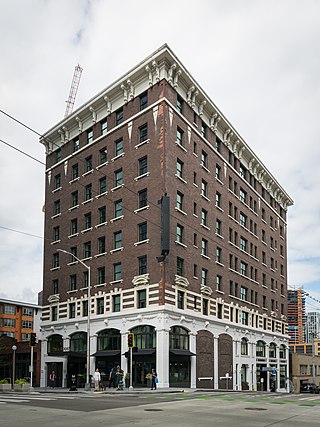
The Calhoun Hotel, later known as the Palladian Apartments and currently the Kimpton Palladian Hotel is a historic hotel building located in downtown Seattle, Washington. Constructed in 1909, The building was built on the recently regraded northeast corner of Second Avenue and Virginia Streets by Scott Calhoun (1874-1952), a well known attorney and Seattle's Corporation Counsel who helped form the Port of Seattle. He commissioned prominent local Architect W. P. White to design an eight-story hotel building, containing 153 rooms on the upper floors and retail at ground level. It was the first building to be completed on the site of the Denny Regrade. It was listed on the National Register of Historic Places on April 23, 2013. Converted to apartments by the 1980s, In 2014 it was restored back into a hotel and is currently run by the Kimpton Hotels & Restaurants brand as the Kimpton Palladian Hotel.
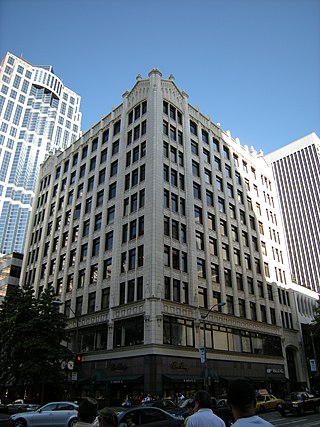
The Liggett Building, also referred to as the Fourth & Pike Building, is a historic 10-story office building at 1424 4th Avenue in downtown Seattle, Washington. It was built in 1927 by the Louis K. Liggett Company, leasing the property from the estate of local pioneer George Kinnear, to house the first Seattle location of their national drug store chain. Liggett's would break their 99-year lease on the building only a few years later after having opened a second location only a block away proved financially unwise during the Great Depression. The building received its current name after a 1933 renovation. Designed by Lawton & Moldenhour in the Gothic revival style, it is clad entirely in locally manufactured terracotta. It is an official Seattle City Landmark and was listed on the National Register of Historic Places on August 31, 2011.

The Rector Hotel, later known as the St. Charles Hotel and during the 1930s the Governor Hotel, is a historic hotel building located at the Southwest corner of Third Avenue and Cherry Street in downtown Seattle, Washington. It was constructed in the latter half of 1911 by the estate of pioneer lumber baron Amos Brown. Designed by prominent Seattle architect John Graham, Sr., the original plans were for a twelve-story building that would be built in two phases but the top 6 floors were never added. Originally a hotel serving the tourist trade, by the 1970s it was operating as a Single resident occupancy hotel. In 1986 it was renovated into low-income housing by the Plymouth Housing Group. In 2002 it was added to the National Register of Historic Places.

The Interurban Building, formerly known as the Seattle National Bank Building (1890–1899), the Pacific Block (1899–1930) and the Smith Tower Annex (1930–1977), is a historic office building located at Yesler Way and Occidental Way S in the Pioneer Square neighborhood of Seattle, Washington, United States. Built from 1890 to 1891 for the newly formed Seattle National Bank, it is one of the finest examples of Richardsonian Romanesque architecture in the Pacific Northwest and has been cited by local architects as one of the most beautiful buildings in downtown Seattle. It was the breakthrough project of young architect John Parkinson, who would go on to design many notable buildings in the Los Angeles area in the late 19th and early 20th century.

The Mutual Life Building, originally known as the Yesler Building, is an historic office building located in Seattle's Pioneer Square neighborhood that anchors the West side of the square. The building sits on one of the most historic sites in the city; the original location of Henry Yesler's cookhouse that served his sawmill in the early 1850s and was one of Seattle's first community gathering spaces. It was also the site of the first sermon delivered and first lawsuit tried in King County. By the late 1880s Yesler had replaced the old shanties with several substantial brick buildings including the grand Yesler-Leary Building, which would all be destroyed by the Great Seattle Fire in 1889. The realignment of First Avenue to reconcile Seattle's clashing street grids immediately after the fire would split Yesler's corner into two pieces; the severed eastern corner would become part of Pioneer Square park, and on the western lot Yesler would begin construction of his eponymous block in 1890 to house the First National Bank, which had previously been located in the Yesler-Leary Building. Portland brewer Louis Feurer began construction of a conjoined building to the west of Yesler's at the same time. Progress of both would be stunted and the original plans of architect Elmer H. Fisher were dropped by the time construction resumed in 1892. It would take 4 phases and 4 different architects before the building reached its final form in 1905. The Mutual Life Insurance Company of New York only owned the building from 1896 to 1909, but it would retain their name even after the company moved out in 1916.

The Beezer Brothers were American architects active from the late 19th-century to the Great Depression. They were twins, who practiced together in western Pennsylvania before moving to Seattle, Washington in 1907 to participate in the city's rapid growth brought on by the Klondike Gold Rush. Best known for the many Catholic churches they designed, they also worked on domestic residences and municipal buildings. Their work on the west coast, while concentrated in Seattle, can be found from Los Angeles to San Francisco to Alaska, and inland to Montana. At least one church and two buildings are individually listed on the National Register of Historic Places, and several other buildings are contributing properties to several different National Historic Districts.

